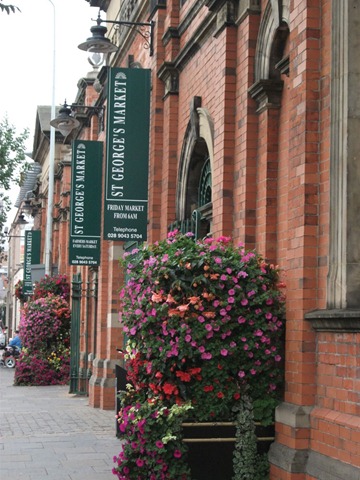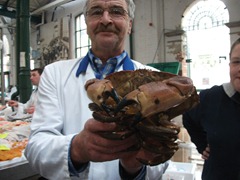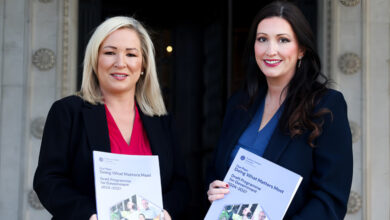St George’s Market
 An eclectic mix of tastes, traditions and good value means that traders at St George’s Market are busier than ever despite the economic downturn. Meadhbh Monahan reports.
An eclectic mix of tastes, traditions and good value means that traders at St George’s Market are busier than ever despite the economic downturn. Meadhbh Monahan reports.
Vestiges of Belfast’s past are still evident among the city’s oldest Victorian market where, on a wet Saturday morning, hundreds of locals, tourists and passers-by meander around the building which was built in three phases from 1890 to 1896.
Outside, visitors are greeted by the Belfast coat of arms above the Roman arch entrance. This is accompanied with engravings of the city’s Latin motto: ‘pro tanto quid retribuamus’ – which means ‘what shall we give in return for so much?’ – and the Irish phrase ‘lámh dearg na hÉireann’, or ‘red hand of Ireland’.
Inside, the pendulum of an antique clock swings at a steady pace while the noise from a live band and the rain falling on the Bangor blue slate and glass roof, echo around the large space.
In the late 1980s Belfast City Council considered another purpose for the building because of increasing maintenance costs and the fact that it was only used once a week. However, a campaign by Friends of St George’s Market resulted in a £3.5 million refurbishment programme backed by the Heritage Lottery Fund and the Environment and Heritage Service.
During the two-year restoration period,
St George’s elegant Victorian character was refurbished using Blaxter stone to complement the original Glasgow-made stonework and the cast iron columns and exterior gates were sandblasted and painted in the original holly green. The renovated St George’s Market opened its doors in May 1999.
Originally built for the sale of butter, eggs, poultry and fruit, the market now provides produce from across the globe.
As well as fish landed at Portavogie, pork from Cookstown, beef from Armagh, venison, pheasant and local organic vegetables, the Saturday market features treats such as wild boar, Spanish tapas, cheeses, teas and coffees from around the world, French crepes and Caribbean cuisine.
It is also open on Fridays and, more recently, Sundays. On these occasions, traders peddle wares such as clothes, antiques, art, crafts, jewelry, plants, cakes, eggs, poultry, meat and hardware.
In addition, artisans and craftspeople often demonstrate the traditional way to weave linen and wool, make baskets and poker heads, and cook soda farls.
 Fishmonger Alan Coffey has been trading at St George’s Market for 32 years. He has witnessed many changes, particularly in cooking trends.
Fishmonger Alan Coffey has been trading at St George’s Market for 32 years. He has witnessed many changes, particularly in cooking trends.
“When I first started, I mainly traded in white fish, smoked fish and herring, that’s about it,” he recalls.
“Now that people go away on these exotic holidays and see all these different fish, when they come back they want the same at home.”
His business ‘Something Fishy’ now sources fish from all over the world.
“We had lovely yellow fin tuna from the Indian Ocean there today and it’s nearly all away,” he explains.
His Atlantic cod was caught the previous Saturday, he received it on Wednesday morning and it too was almost sold out.
“Our scallops, because the local season is over, are coming from Scotland at the moment. We have lovely mussels from Strangford Lough and we also have lovely big langoustines [king prawns] that were caught in the deep deep water just off Portavogie,” Coffey adds.
A public auction is held in Portavogie five nights a week and it is there that the bartering is done and his produce acquired.
When asked how he has found the recession, Coffey says: “Fortunately people have to eat. They used to go out for meals but now with the economic downturn and celebrity chefs on TV, they are cooking in their homes and experimenting more.”
He has seen an increase in Portuguese and Spanish customers and regularly sells his sea food to the lawyers and barristers who come across the road from the court house.
Greengrocer Gerry Lappin is a newer addition to the market. He has been trading for two years and finds that although Friday and Saturday remain busy, demand for fruit and vegetables on a Sunday is less.
“I’ve been trading in St George’s for two years and I’ve found it to be very good,” he says. “I have noticed more people shopping here rather than eating in restaurants. The markets are popular because you can get stuff fresh and often at a better price than the big supermarkets.”
Despite this, he says that competition from the supermarkets affects him “big-time.”
As with the fish, Lappin has noticed more exotic requests from customers recently. These include papaya, lychees, and dragon fruit. He sources his produce from a market held on the Boucher Road every week.
 Butcher John McCarthy has had his stall at the market on May Street for 20 years. He told agendaNi: “People come to the markets looking for a bargain, and they get it.”
Butcher John McCarthy has had his stall at the market on May Street for 20 years. He told agendaNi: “People come to the markets looking for a bargain, and they get it.”
McCarthy has found business easier to transact over the last two decades because Belfast is now a more peaceful city.
“The main changes have been since the peace process. We worked here on a Friday and we nearly always had to get out for an hour for the bomb scares,” he explains. “It’s a lot more packed now because there are a lot more tourists about, especially from Dublin, and especially on a Saturday.”
Commenting on other trends, he recalls: “Years ago, when I first started we were mainly poultry farmers and we used to always sell boiling fat. I think we are the only ones on the market that still sell boiling fat.”
He explains: “Every housewife years ago bought boiling fat and they used the left-over chicken in sandwiches and cooked the bones for soup. Now with the increase of free range and organic [produce] it’s not so popular.”
Has the economic downturn affected him? “Yes,” he remarks, “we have got busier.”





